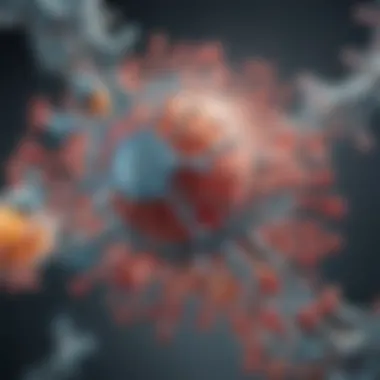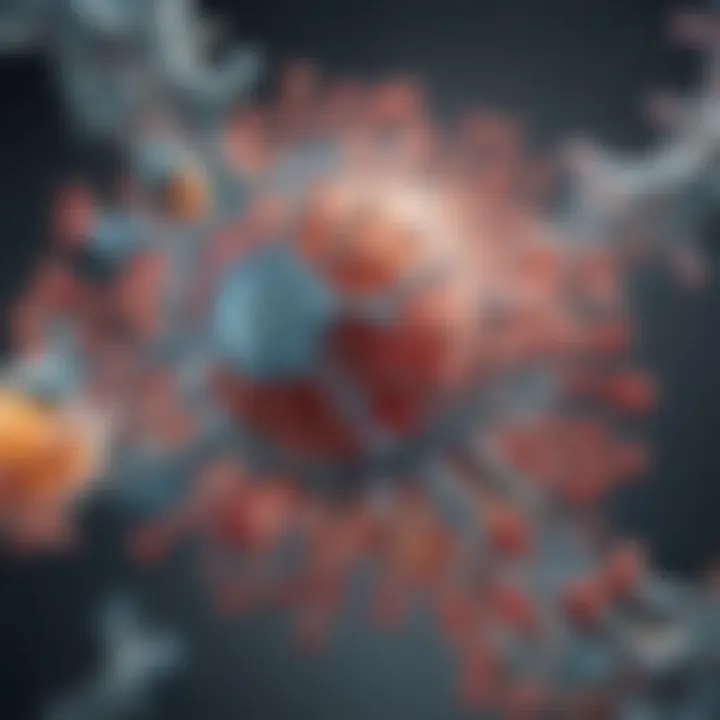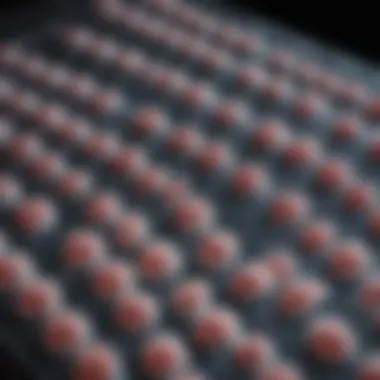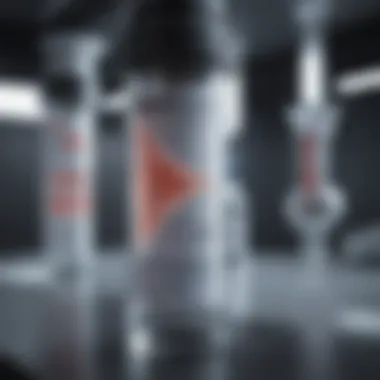Exploring the mRNA Pneumonia Vaccine: Mechanisms and Efficacy


Intro
The advent of mRNA technology has opened up new frontiers in the field of vaccination, particularly in the pursuit of strong defenses against complex diseases such as pneumonia. Pneumonia, often triggered by various pathogens, has long posed a significant threat to public health around the world. As medical researchers and vaccine manufacturers intensify their efforts, the concept of an mRNA pneumonia vaccine has emerged, promising a breakthrough immune response that could enhance our ability to prevent infection.
The transformative potential of this innovative approach stems from its unique mechanisms designed to utilize the body’s own cellular machinery. Unlike traditional vaccines that may rely on weakened or inactive forms of pathogens, mRNA vaccines equip the immune system with the tools to recognize and combat invaders more effectively. This aspect not only brings new life into the conversation surrounding vaccine development but also underscores the collaborative efforts of scientists striving to keep pace with evolving threats to respiratory health.
In this article, we will explore the intricate workings of the mRNA pneumonia vaccine, assessing its efficacy in diverse settings while situating it within the broader landscape of immunization strategies. The intertwining of scientific frameworks and clinical implications will also be examined to provide readers—from experienced medical professionals to intrigued laypersons—with a comprehensive understanding of where we stand and where we might be headed in the realm of vaccinating against pneumonia.
Prelims to mRNA Technology
The landscape of medicine is constantly shifting, guided by breakthroughs in various scientific fields. Among these, mRNA technology stands out like a beacon of hope, having the potential to revolutionize how we approach vaccines, especially in the case of infectious diseases. Understanding the introduction of mRNA technology is vital, not just for academics or researchers, but for anyone interested in the future of healthcare and how society deals with respiratory illnesses like pneumonia.
What is mRNA?
Messenger RNA, or mRNA, is a natural molecule found in all living cells. It plays a crucial role in translating genetic information from DNA into proteins that carry out vital functions in our bodies. Essentially, mRNA serves as a template, guiding the production of proteins—the building blocks of life. When a cell needs to produce a specific protein, it synthesizes an mRNA copy of the related gene. This mRNA exits the nucleus, bringing the instructions needed to make proteins into the cell's cytoplasm, where cellular machinery gets to work.
Understanding this basic function of mRNA is fundamental, as it sets the stage for the development of mRNA vaccines. Unlike traditional vaccines, which often use weakened or inactivated pathogens, mRNA vaccines instruct cells to create a harmless piece of the target virus, prompting the immune system to recognize and combat the real virus when exposed.
The Evolution of mRNA Vaccines
The journey of mRNA vaccines began as a distance twinkle in the eye of researchers. Initially, scientists faced various challenges, including instability and the body’s immune response against the synthetic mRNA. However, advancements in lipid nanoparticles have made it possible to protect the mRNA throughout the body, ensuring that it reaches its target cells effectively. Just a few years ago, mRNA vaccines were largely experimental. But everything changed with the emergence of the coronavirus pandemic, which drove unprecedented acceleration in mRNA technology's research and utility.
Now, major vaccines such as the Pfizer-BioNTech and Moderna formulations utilize mRNA technology to provoke a robust immune response against SARS-CoV-2. This recent evolution underscores how adaptable and promising mRNA vaccines can be, not only for COVID-19 but also for other respiratory pathogens that contribute to pneumonia.
Advantages of mRNA Vaccines
The advantages of mRNA vaccines can hardly be overstated. Here’s a quick rundown of why they are considered a game changer:
- Rapid Production: Once the genetic sequence of a virus is identified, mRNA vaccines can be designed and produced in a matter of weeks, a significant leap compared to traditional methods that can take months or even years.
- Safety Profile: mRNA vaccines do not enter the cell’s nucleus and do not alter DNA. This offers a more favorable safety profile, making it attractive to develop new vaccines without some of the risks associated with live-attenuated vaccines.
- Flexibility: mRNA technology can adapt quickly to emerging pathogens, allowing for the timely development of vaccines in response to outbreaks. Imagine a world where we can respond to threats as quickly as they arise!
- Robust Immunity: Studies are showing that mRNA vaccines generate not just immediate immune responses but also long-lasting immune memory. This memory helps the body to recognize and fight future infections more efficiently.
In light of these advantages, mRNA vaccines could change the course of pneumonia treatment and prevention, challenging traditional vaccination methods.
"The beauty of mRNA technology is its versatility; it can be tailored to target a wide array of pathogens without the constraints of conventional vaccine platforms."
In this way, the exploration into the mRNA pneumonia vaccine highlights the importance of grasping its foundational technology, paving the way for a deeper exploration of its mechanisms, efficacy, and future possibilities.
Pneumonia: An Overview
Pneumonia represents a significant public health concern worldwide. It's not just a simple cold or flu; it can lead to severe complications and, in some cases, death. By understanding pneumonia, its causes, and its consequences, we can better appreciate the role of vaccines, particularly the new mRNA pneumonia vaccine. This section offers a comprehensive overview of pneumonia, shedding light on its essentials in the context of immunization strategies.
Understanding Pneumonia
Pneumonia is an infection that inflames the air sacs in one or both lungs, which can fill with fluid or pus. Its symptoms range from mild to severe, typically including cough, fever, chills, and difficulty breathing. It can strike people of any age but is particularly dangerous for infants, seniors, and those with compromised immune systems. The severity of pneumonia can vary widely, ranging from a fairly mild illness that can be managed at home to a life-threatening condition requiring hospitalization.
Pneumonia is often underestimated but can have serious health repercussions.
The importance of recognizing pneumonia lies in its potential for rapid deterioration, leading to complications such as sepsis, lung abscesses, or respiratory failure. The condition's complexity warrants a thorough understanding, as early intervention can significantly impact recovery time and health outcomes.
Causes and Pathogens
Pneumonia can be caused by various pathogens: bacteria, viruses, and fungi. The most common culprits include:


- Bacteria: The bacterium Streptococcus pneumoniae is the leading cause of bacterial pneumonia in adults. Other notable bacteria include Haemophilus influenzae and Mycoplasma pneumoniae.
- Viruses: Viral pneumonia can be caused by influenza viruses, respiratory syncytial virus (RSV), and coronaviruses, including SARS-CoV-2.
- Fungi: Fungal pneumonia is less common and often occurs in immunocompromised individuals. Common agents include Histoplasma capsulatum and Coccidioides immitis.
Understanding these pathogens is crucial for effective treatment and prevention strategies. Different pathogens require different treatment approaches, often necessitating specific vaccines that can protect against the most threatening types.
Impact of Pneumonia on Public Health
Pneumonia significantly burdens healthcare systems globally. It is a leading cause of morbidity and mortality, particularly among vulnerable populations like children under five and adults over sixty-five. According to the World Health Organization, pneumonia accounts for approximately 14% of all deaths of children under five, making it a critical area for public health improvement.
The direct and indirect impacts of pneumonia extend beyond the immediate health implications. Hospitalizations due to pneumonia can strain healthcare resources and lead to increased healthcare costs. Additionally, the illness can also hinder workforce productivity due to prolonged absenteeism.
- Economic Impact: Treating pneumonia can place a heavy financial burden on healthcare systems. Hospitals incur costs related not only to treatment but also to managing complications.
- Social Burden: Families can face significant emotional and financial stresses when caring for someone hospitalized due to pneumonia.
In summary, pneumonia is more than just an illness; it is a substantial public health issue that calls for innovative solutions, including the development and implementation of vaccines. Understanding pneumonia's essence allows us to grasp the significance of mRNA vaccines in not only combating current strains but also in paving the way for future health advancements.
Mechanisms of Action in mRNA Pneumonia Vaccines
Understanding the mechanisms of action in mRNA pneumonia vaccines is vital for comprehending how these innovative vaccines bolster the immune system to prevent pneumonia. The process hinges on several interrelated components that ensure the vaccines are both effective and efficient at provoking an immune response. An appreciation for these mechanisms reveals not only the scientific ingenuity but also the potential of mRNA technology in modern medicine.
How mRNA Triggers an Immune Response
The second step begins with how mRNA triggers an immune response. This process is intricate, but it ultimately leads to the development of a robust immunity against pneumonia. Three primary avenues characterize this interplay: delivery methods, cellular uptake, and protein synthesis.
Delivery Methods
Delivery methods are fundamental to the effectiveness of mRNA vaccines. The key characteristic of these methods is their ability to transport mRNA into human cells. Lipid nanoparticles serve as the preferred vehicles due to their small size and ability to encapsulate mRNA, ensuring its stability while stimulating an immune reaction. This makes lipid nanoparticles a beneficial choice since they protect mRNA from degradation before it reaches its target. A unique feature of these delivery methods lies in their capacity for targeted delivery, allowing the mRNA to enter cells more efficiently. However, one challenge with delivery methods can be inconsistency in how well different cells uptake the mRNA, which may lead to variability in immune responses across individuals.
Cellular Uptake
Next comes cellular uptake, the moment when the mRNA enters human cells. This aspect is crucial since it defines whether the vaccine will be effective in eliciting an immune response. A defining characteristic of cellular uptake in mRNA vaccines is the use of endocytosis—cells engulfing external materials to allow the mRNA to slip through their membranes. This method is popular because it is inherently natural to the cell's operation. A unique trait to note is the efficiency of mRNA uptake when facilitated by the lipid nanoparticles, leading to more predictable responses. On the downside, there may be variability in how actively different types of cells can take in the mRNA, which can slightly impact overall effectiveness.
Protein Synthesis
At the heart of the immune response lies protein synthesis, where the magic happens. Once inside the cell, the mRNA utilizes the cell’s machinery to produce specific proteins, usually those resembling surface proteins of the pathogens that cause pneumonia. The key characteristic here is rapid protein synthesis, enabling the body to generate a quick immune response. This is advantageous because it can lead to faster recognition and neutralization of pathogens, a critical factor in preventing illness. A unique feature of this process is that it creates an accurate representation of the pathogen’s proteins, prompting the immune system to learn and remember them. However, facilitating protein synthesis requires finely tuned processes. Any hiccup in these mechanisms could compromise the quality of immune response.
Immune Memory Formation
The next essential element is immune memory formation. This is a pivotal aspect of mRNA vaccines, determining long-term immunity. Immune memory refers to the process by which the immune system remembers previous encounters with specific pathogens. Once the mRNA has led to the production of pathogen-like proteins, immune cells called B cells and T cells establish memory. B cells remember specific antigens and produce antibodies for faster response in future exposures, while T cells can develop into memory T cells capable of rapidly responding to invaders. This resilience is what gives mRNA vaccines an edge. Effective immune memory formation can ensure that the body is adequately prepared to counteract pneumonia pathogens long after the initial vaccination. Understanding this mechanism helps clarify the potential longevity of the mRNA pneumonia vaccine’s protective effects.
Clinical Trials and Efficacy Studies
Clinical trials and efficacy studies play a pivotal role in the development and validation of mRNA pneumonia vaccines. These studies are fundamental not just in proving the vaccines' ability to elicit a robust immune response but also in assessing how effective they are in preventing pneumonia caused by various pathogens. One might say, it’s the bread and butter of vaccine science, providing the necessary evidence to assure healthcare professionals and the public that a vaccine is not just a shot in the dark.
Through rigorous testing phases, researchers can identify optimal dosing, monitor side effects, and analyze the overall performance of a vaccine in diverse populations. Importantly, the findings from these trials contribute to FDA approvals and recommendations for widespread use, setting the stage for public health initiatives aimed at combating pneumonia effectively.
Overview of Recent Clinical Trials
Recent clinical trials conducted on mRNA pneumonia vaccines have mainly focused on assessing their safety, immunogenicity, and efficacy against well-known pathogens. For instance, some trials have been conducted in different geographical regions to evaluate how well these vaccines perform in various demographic groups, taking into account age, health status, and pre-existing conditions. The trials have produced a wealth of data, suggesting that mRNA vaccines show promising results in stimulating the body’s immune response, which is crucial for generating immunity against pneumonia.
Altogether, the findings herald a new chapter where rapid development and evaluation are possible, thanks to the genomic sequencing capabilities we have today. As they say, necessity is the mother of invention.
Efficacy Against Specific Pathogens
Streptococcus pneumoniae


Streptococcus pneumoniae poses a significant health threat as a common cause of pneumonia. As a specific focus for mRNA vaccine development, it exhibits diverse serotypes, which presents both an opportunity and a challenge. The key characteristic of this bacterium is its ability to evade the immune response, making it a prime candidate for vaccination efforts. The mRNA vaccine enhances the production of antibodies that specifically target S. pneumoniae, allowing for a protective response that was previously hard to achieve with traditional vaccines.
The unique feature about targeting this pathogen is that mRNA technology allows for a quicker response to emergent strains, adapting the vaccine formulation as necessary. This flexibility is a considerable advantage over conventional vaccination methods that often become outdated as pathogens evolve. Given the high disease burden associated with S. pneumoniae, the implications of effective vaccination are immense—potentially reducing hospitalization rates and improving health outcomes.
Other Respiratory Pathogens
Shifting focus to other respiratory pathogens illuminates the diverse landscape of pneumonia-causing agents. Viruses like influenza and other atypical bacteria also contribute to respiratory illnesses. The key characteristic of these pathogens is their varied mechanisms of infection and transmission, showcasing the need for a broad-spectrum vaccine approach.
What makes investigating these pathogens worthwhile is the potential for mRNA vaccines to cover multiple targets simultaneously. This feature is particularly advantageous in the context of co-infections, where a single individual may be stricken by more than one pathogen at once, complicating treatment and management strategies. Moreover, with the rise of new and variant strains of respiratory viruses, maintaining the efficacy of vaccines becomes vital in a constantly shifting infectious landscape.
Comparative Analysis with Traditional Vaccination
In comparing mRNA vaccines with traditional vaccination methods, several distinctions arise.
- Speed of Development: mRNA vaccines can be designed and modified rapidly in response to emerging pathogens, which is a stark contrast to the often lengthy process of creating traditional vaccines.
- Immune Response: Studies indicate that mRNA vaccines may produce a stronger and more prolonged immune response, facilitating not just immediate protection but also long-term immunity.
- Safety Profile: While traditional vaccines carry risks of allergic reactions and other side effects, mRNA vaccines generally have a favorable safety profile, though monitoring continues as the rollout expands.
In summary, clinical trials and efficacy studies provide the compass guiding the future of mRNA pneumonia vaccines, helping navigate through challenges while capitalizing on the advancements in medical science.
Safety and Side Effects
Understanding the safety profile and potential side effects of mRNA vaccines is crucial. As these vaccines are relatively new technology, apprehensions surrounding their use have emerged. Public confidence hinges on comprehensible data about their safety, particularly for individuals at risk for pneumonia, such as the elderly and those with preexisting respiratory conditions. Ensuring safety minimizes hesitancy and fosters acceptance in diverse populations, thus promoting wider immunization coverage.
Common Side Effects of mRNA Vaccines
When considering the administration of mRNA vaccines, most individuals can expect some level of side effects. These reactions often reflect the body’s immune response to the vaccine, which is a positive sign indicating that the immune system is gearing up to fight off potential infections. Common side effects include:
- Injection site pain or swelling: A sore arm where the shot was given is notably prevalent.
- Fatigue: Many report feeling unusually tired for a day or two.
- Headache: Some individuals may experience mild headaches, sometimes accompanying fatigue.
- Muscle pain: A feeling of soreness, particularly after the second dose, can be common.
- Fever or chills: A temporary fever might occur as the immune system responds.
- Nausea: Some people may feel a bit nauseous post-vaccination.
These side effects generally resolve within a few days and are typically mild to moderate in intensity. Notably, serious adverse reactions remain rare, affirming mRNA vaccines' overall safety.
Long-Term Safety Considerations
Concerns regarding the long-term safety of mRNA vaccines, especially considering their novel technology, are understandable. Scientific communities continue to monitor these vaccines' effects over extended periods. Presently, a few key points break down long-term safety considerations:
- Ongoing Surveillance: Post-vaccination, health organizations actively collect data to track any rare side effects that may arise months or even years later. This continuous monitoring allows for timely responses should any issues be identified.
- Duration of Immunity: Current studies suggest that the immunity provided by mRNA vaccines may wane over time, sparking inquiries about the necessity of booster doses. Understanding the length of protection is essential for future immunization strategies.
- Impact of Variants: The emergence of new variants necessitates regular evaluations of the vaccines' effectiveness across various strains of pneumonia pathogens. Adjustments, if necessary, should be made to ensure ongoing efficacy.
Challenges in Implementation
Implementing the mRNA pneumonia vaccine comes with a set of hurdles that need to be jumped over carefully, just like a cat avoiding puddles on a rainy day. These challenges can impact not just the delivery of the vaccine, but also public health outcomes. In this section, we will explore logistical hurdles and public perceptions that can shape the path of this novel vaccine.
Logistical Hurdles
Cold Chain Requirements
Cold chain requirements are a significant consideration in the deployment of mRNA vaccines. These vaccines require precise temperature control during storage and transport, typically around -80°C. This is crucial because exposing mRNA to higher temperatures can lead to its degradation.
A key characteristic of these cold chain systems is their complexity. When you think about it, maintaining such low temperatures throughout the entire distribution process demands robust infrastructure and resources. This can be a sticking point, especially in regions where resources are stretched thin.
The unique feature of these cold chain processes is that they ensure the integrity of the vaccine, but they come with both advantages and disadvantages. On the one hand, they help maintain high efficacy rates; on the other, they pose logistical challenges in terms of expense and accessibility. For example, if a rural clinic cannot afford the specialized storage units or the regular monitoring required, it could lead to wasted doses and decreased vaccination rates.
Distribution in Low-Resource Settings


Distribution in low-resource settings presents another hurdle in the vaccine rollout. Many regions, particularly in developing countries, face challenges such as poor infrastructure, limited refrigeration capabilities, and inadequate transportation networks. These factors can slow down the pace of vaccination efforts.
What stands out about distributing vaccines in these settings is the need for tailored solutions. Solutions that take into account local challenges, like deploying mobile vaccination units or establishing community-based distribution systems, can be incredibly beneficial. Yet, it is also a balancing act. The complex logistics involved may require outside support and funding, which isn't always guaranteed.
The unique feature of low-resource settings is their variance from region to region. While some may have local leaders who can mobilize communities, others might have to rely on international aid to facilitate distribution. The disparities can lead to delay in vaccination, hence affecting overall immunization goals.
Public Perception and Acceptance
The success of mRNA pneumonia vaccines hinges not only on scientific advancements but also on how the public perceives them. Acceptance within communities can drastically shift the vaccination landscape. Misunderstandings or negative sentiments can result in lower vaccination rates, making it all the more essential to address public concerns.
Effective communication is critical here. Efforts to educate the public about the safety, efficacy, and necessity of these vaccines can go a long way in gaining confidence. Additionally, engaging community leaders and influencers can be vital in creating a trusted narrative.
Addressing misinformation head-on can transform skepticism into acceptance. Understanding the cultural context and values in each community can further strengthen these initiatives, slowly reshaping attitudes towards this cutting-edge technology.
"Public perception plays as much a role in health outcomes as the science behind the vaccine itself."
In summary, the many challenges of implementing mRNA pneumonia vaccines stretch from cold storage logistics to public acceptance. Navigating these hurdles requires careful planning and innovative solutions, with the ultimate goal of enhancing healthcare and community health outcomes.
Future Directions and Research
The field of mRNA vaccines represents a frontier of innovation in immunization. As research and development advance, the potential for mRNA vaccines extends far beyond their initial applications. This next phase is crucial for addressing current challenges and unlocking new therapeutic avenues. Understanding the future directions in this domain can illuminate pathways towards more effective vaccines and broader public health applications.
Next-Generation mRNA Vaccines
Multivalent Vaccines
Multivalent vaccines are designed to provoke an immune response against several strains or types of pathogens through a single formulation. The beauty of this approach lies in its efficiency; it allows for immunization against multiple threats with fewer injections. For instance, developing a multivalent mRNA vaccine for pneumonia could target Streptococcus pneumoniae along with other prevalent respiratory pathogens.
One key characteristic of multivalent vaccines is their ability to provide comprehensive coverage, effectively broadening the scope of protection. This means patients can benefit from reduced vaccine schedules and increased compliance. However, it’s important to note that the complexity of formulating a multivalent vaccine presents distinct challenges, particularly in ensuring balanced immune responses to all included antigens. This consideration might complicate the design process but ultimately aims to yield a more robust protective effect.
Combination Approaches
Combination approaches involve integrating mRNA vaccines with other modalities, such as traditional vaccines or therapeutic agents. This strategy can enhance overall efficacy by leveraging synergies between different vaccine technologies. For example, combining mRNA vaccines with live attenuated vaccines could potentially boost immune responses, creating a more formidable barrier against pathogens.
A defining characteristic of combination approaches is their adaptability. They can be tailored to address specific public health challenges, such as emerging infectious diseases or evolving strains of existing pathogens. However, there is also the reality that combining different types of vaccines requires meticulous study to ensure safety and effectiveness. Adverse reactions might arise from interactions between the components, necessitating thorough clinical trial evaluations before widespread implementation.
Potential Applications Beyond Pneumonia
The versatility of mRNA technology holds promise far beyond pneumonia vaccines. Researchers are investigating its application in a variety of infectious diseases, cancers, and even personalized medicine. For instance, there’s ongoing exploration into mRNA vaccines targeting melanoma and other malignancies, showcasing the adaptability of this technology.
Furthermore, mRNA platforms could be invaluable in responding swiftly to emerging viral outbreaks, equipping public health agencies with tools to create vaccines tailored to new threats. The rapid production capability of these vaccines differentiates them from traditional approaches, providing agility in outbreak scenarios.
The horizon for mRNA vaccines is wide-ranging and full of potential. As the scientific community deepens its understanding of these mechanisms and explores new delivery methods, the next generation of vaccines will bring forth innovations that could transform preventive medicine.
Epilogue
The conclusion of this article serves as a pivotal moment to reinforce the significance of the mRNA pneumonia vaccine in today's evolving healthcare landscape. Understanding mRNA technology is not merely an academic pursuit; it plays a crucial role in shaping future vaccination strategies. This innovative approach to immunization has the potential to combat pneumonia effectively, a common but serious respiratory illness that can lead to dire consequences.
Summarizing Key Findings
In reviewing the core content, several key findings emerge:
- Mechanisms of Action: The mRNA pneumonia vaccines utilize sophisticated mechanisms that enable the body to recognize and mount a robust immune response against pathogens like Streptococcus pneumoniae. These vaccines introduce messenger RNA, prompting cells to produce specific proteins that elicit an immune reaction.
- Efficacy: Clinical trials highlight the efficacy of mRNA vaccines against various pneumonia-causing pathogens, boasting protection rates that rival traditional vaccines. Such efficacy underscores the potential of mRNA technology as a frontrunner in immunization efforts.
- Public Health Impact: The implications of widespread mRNA vaccination against pneumonia are significant. Reduced incidence of pneumonia would not only alleviate healthcare burdens but also enhance community health outcomes globally.
The Future of mRNA Vaccines in Medicine
The horizon for mRNA vaccines appears promising. As research evolves, the potential applications expand beyond pneumonia into other infectious diseases, potentially revolutionizing how we tackle health challenges. With advances in vaccine design, future generations of mRNA vaccines may include multivalent formulations that target multiple pathogens within a single dose, enhancing protection and convenience for individuals.
Increasing collaboration among researchers, public health officials, and pharmaceutical companies remains essential in driving this innovative approach forward. Further, exploring combination strategies with existing vaccines can offer comprehensive immunity that addresses multiple health threats simultaneously.



